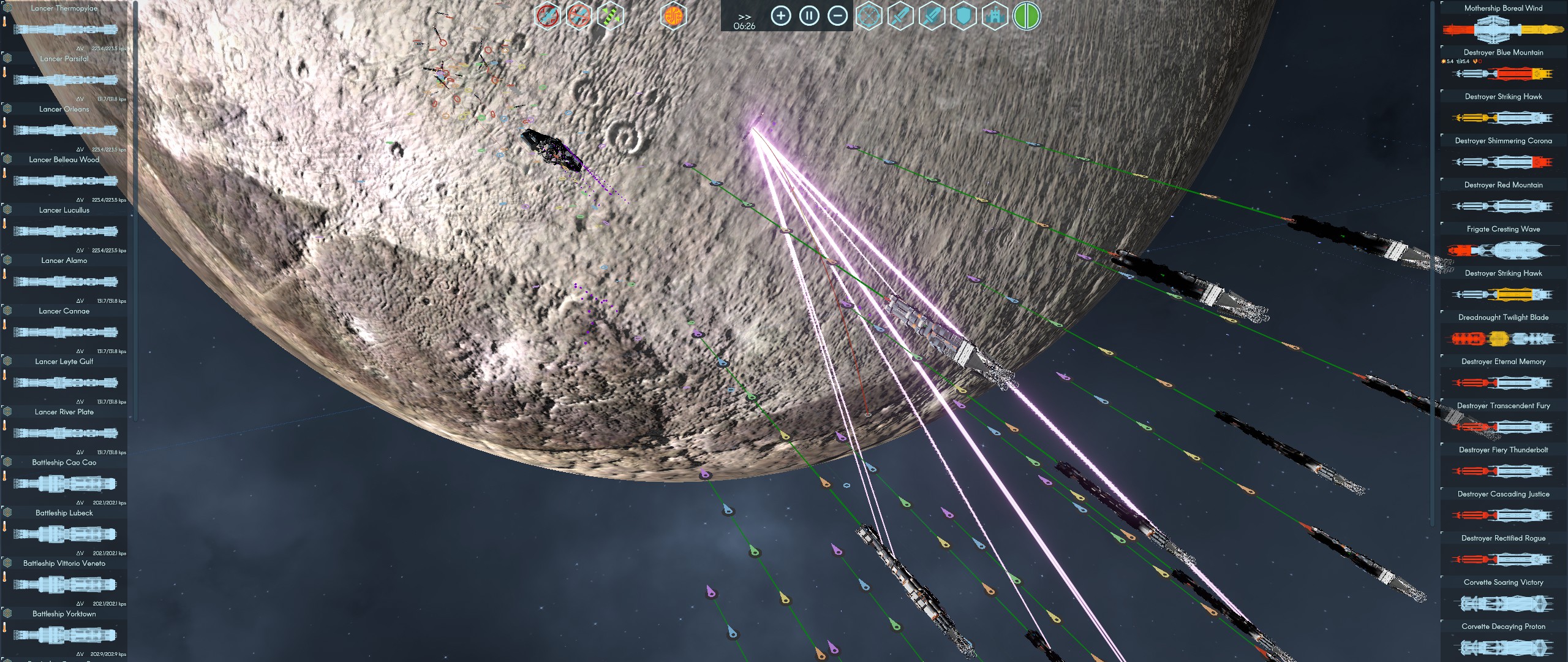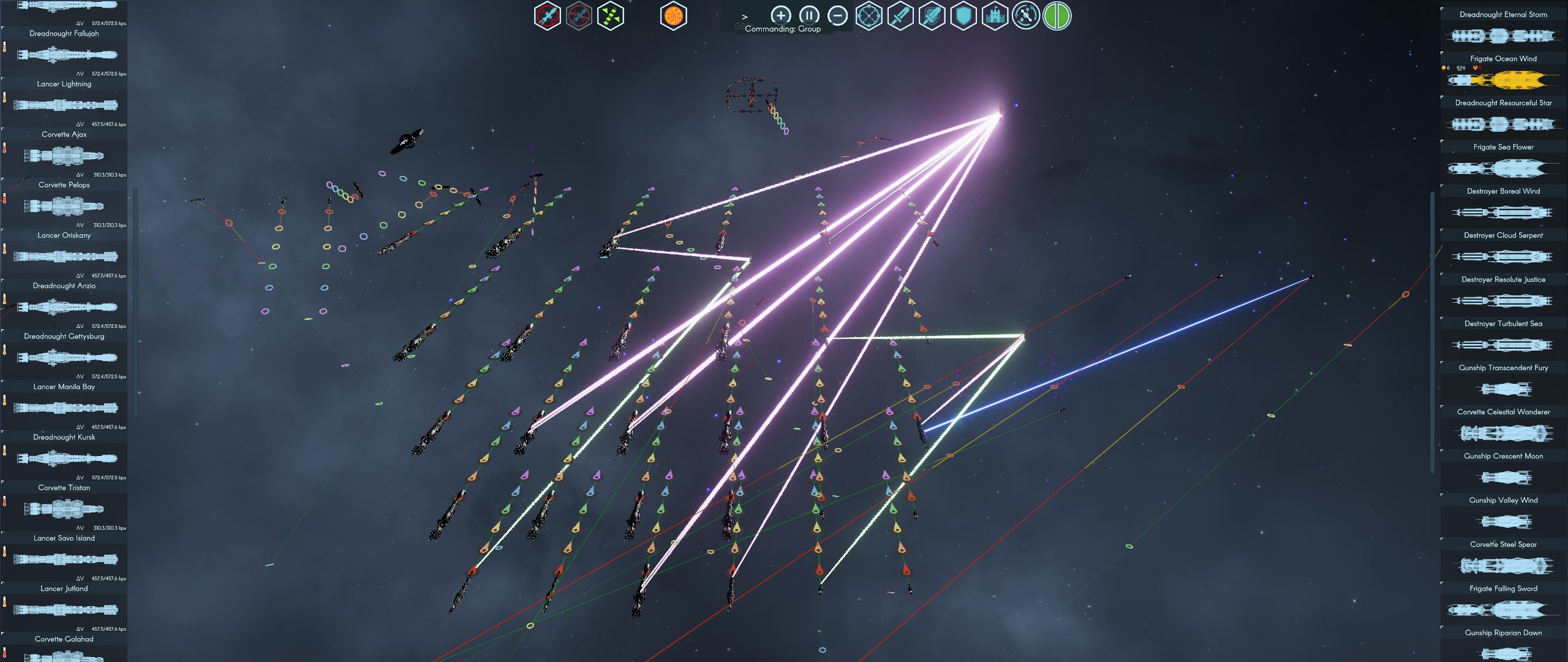In September 2022, in the Terra Invicta timeline, humanity made first contact with aliens.
A decade later, in the 2030s, the aliens landed ground troops on Earth. They cut a swathe of destruction through Earth’s armies before succumbing to superior human numbers. A second wave landed in 2036, attacked several world capitals, and fell prey to the computer players’ nuclear weapons — after I reloaded.
On 25 November 2047, alien fleet Victor-104 swept into its usual hunting grounds, low Earth orbit, and prepared to swat the newly built Oliver Hazard Perry Station out of the sky. Instead, they met the eleven human spacecraft of Earth Command — seven battleships and four armed troop transports. When the dust settled, Earth Command did not lose a single spacecraft. Victor-104 took nearly 100% losses.
On 25 November 2057, exactly ten years later, humanity’s larger, more technologically sophisticated Second Expeditionary Fleet destroyed the aliens’ main fleet in orbit of Makemake, in the Kuiper Belt. And several weeks later, on 1 January 2058, humanity ended the alien threat once and for all.

I previously wrote about Terra Invicta about a week into Early Access. Now that I’ve finished my campaign, I’m very glad I took a chance on the Early Access release. I like how the game proceeds through distinct phases, and how it conveys the feel of an ebbing, flowing war, rather than a diagonal line up and to the right. At the same time, there is room to improve challenge & pacing in the late game. Overall, I think the game is very well placed to fulfill its potential once it comes out of Early Access.

Enjoying the site? Subscribe via email below.
Game progression: through struggle, to the stars
My game progressed through many phases. My earlier post covered the first two:
- Getting started on Earth
- The early race into space, when I established bases on the Moon, Mars, and Mercury in the 2020s

- Fending off the alien ground invasions in the 2030s one timeline (in another, abortive timeline, the aliens captured the Russian nuclear arsenal, making it impossible to completely clear them off Earth. Unable to find a solution, I eventually reloaded)

- The long, painful contest of endurance in the 2030s and 2040s. The aliens waged a bombardment campaign against my offworld stations and mining bases. I slowly researched the fusion drive technology that would form the backbone of my space fleet, while fighting constant wars on Earth as alien infiltrators subverted world governments

- Turning the tide in the 2040s, first tentatively committing my new fleet and then going all-in over Earth in 2047

- Going on the offensive, first in the asteroid belt in 2049, and then pushing the aliens off the moons of Jupiter at the start of the 2050s

- Finally, fielding antimatter-powered fleets for the push into the outer Solar System in the 2050s

In-game, one of my starting characters died of old age, Earth’s political map changed as I unified swathes of the planet, humanity became a multi-planet species, and technologies such as fusion power and genetic engineering would presumably have transformed life on Earth.

In real life, this unfolded over months since the game’s initial early access release in September. The developers released numerous updates for the game, which fixed bugs, tweaked balance, and improved quality of life. I upgraded my PC, which drastically improved performance — a previous bugbear.
What the game did well
The long game highlighted two strengths of Terra Invicta.
First, the phases of the game felt distinct and interesting. In the early game, alien fleets felt like an invincible force of nature. In the middle, they were destructive and dangerous, but I could bleed them white. By the end, they were pests to swat. The Moon went from a crucial first step into space to a backwater. Flying from Earth to Mars went from a major undertaking to a routine patrol. Resources that were in short supply become abundant once I secured the Jovian moons.

Second, Terra Invicta made it enjoyable to play through ups and downs. This is a Solar System-wide war where losing fleets, bases, armies, and countries is inevitable — the trick is recovering afterwards.
Here, the game does better than most of the genre. Strategy games can suffer from a cascading effect where defeat tips the player into a death spiral — losing experienced characters in Firaxis’s XCOM is a good example.
In contrast, Terra Invicta is generally good at giving the player tools to deal with setbacks (the main exception being the nuclear-armed alien administration on Earth), while the sheer scale of the game provides players with strategic depth. There’s even a Steam achievement for winning as the Resistance, Terra Invicta’s XCOM equivalent, after one of the pro-alien factions has already won.
What could be better
Terra Invicta has room to improve its late game, which is lengthy and exhibits the same inverted difficulty curve as XCOM. Once I went on the offensive, the outcome became a foregone conclusion, yet I still had to go a long way before I won.
The issues are solvable — I’d put them into two major categories:
1. High threshold to win
This is easy to solve. I had a unique story objective, which was fine. However, most of the work came from a quantitative victory condition — reducing the relative strength of the alien fleet below a percentage threshold. The solution is, reduce or allow players to customise these quantitative objectives.
This would probably be even more helpful for other factions in the game, some of whom have very grindy objectives.

2. The aliens can’t keep up in the late game
There are several sub-issues here:
2a. Do the aliens need more late-game tools?
Alien capabilities reach a plateau long before humans reach the end of the technology tree. This is tricky to solve: it’s a design issue and probably thematic. But perhaps the aliens would benefit from additional technologies or equipment tiers, unlocked once they take humans seriously. Or, since going to “total war” mode already raises the cap on the number of alien bases, perhaps the increase could be larger.
2b. AI tweaks
A stronger AI would keep the alien fleets competitive for longer. Some of these fixes, I think, would be relatively simple:
- Stay in formation instead of breaking formation at the start of every battle
- Increase the amount of armour on ship designs
- Move away from easily-countered missile spam to plasma weapons
- Mass fleets in friendly territory and commit them en masse, instead of dribbling reinforcements in piecemeal. This was the mistake the aliens made after I wrested away the Jovian moons — they wanted to counterattack but came in dribs and drabs

Conclusions
Several months ago, I wrote that Terra Invicta ”may well turn out to be one of my all-time strategy greats”. Now that I’ve finished the game, I’ll go further and say it may become one of the all-time strategy greats, up there with the pantheon of the 1990s. It is not perfect, and it remains a work in progress. But in a few months of Early Access, the game has already taken great strides, and I’m confident it will be even better by the time it reaches its 1.0 release.
Would I replay it? Given the time required, I can’t see myself playing another grand campaign. But if the developers add shorter scenarios, I might return to the fray.